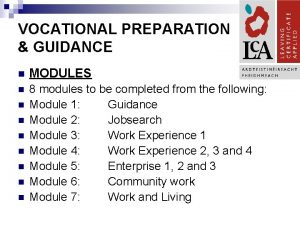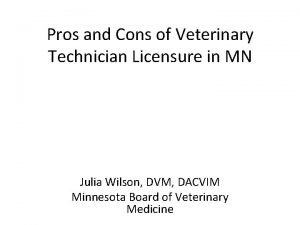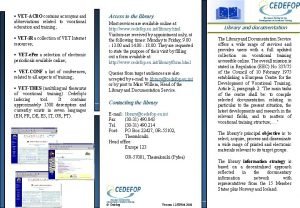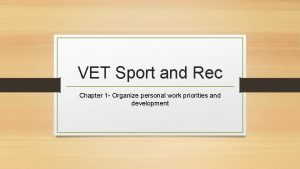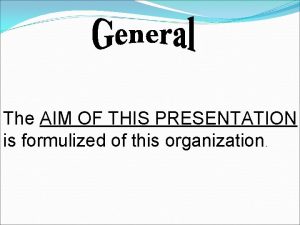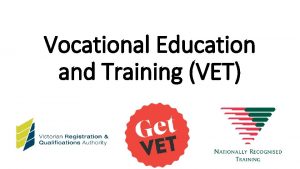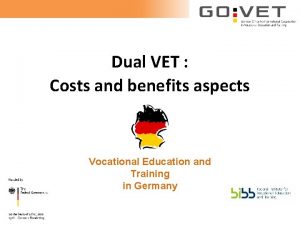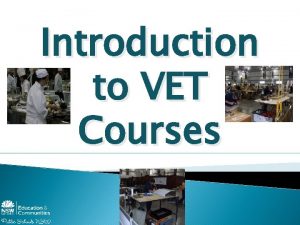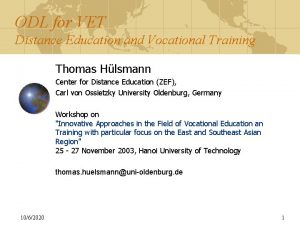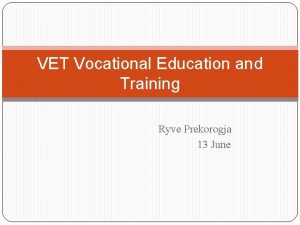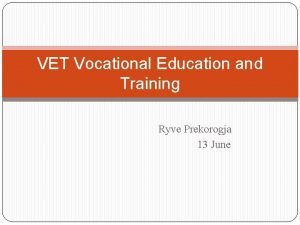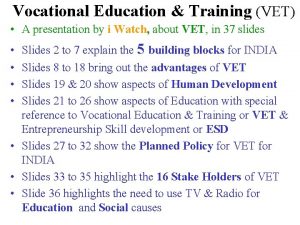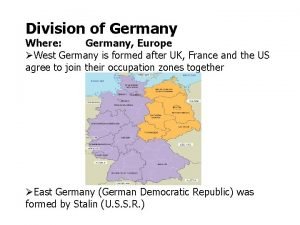Dual VET Vocational Education and Training in Germany


























- Slides: 26

Dual VET Vocational Education and Training in Germany

Contents I. III. IV. V. VII. Overview How Dual VET works Benefits and current challenges Conditions: why Dual VET works in Germany The bottom line: 5 Quality Features of VET Further information Key

I. Overview – Dual VET: a common path to employment General Education Higher Education 3. 5 - 6 years Dual VET System 10 - 13 school years 2 - 3. 5 years Full-time Vocational Schools 2 - 3. 5 years Labour Market

I. Overview – Dual VET facts and figures Trainees • On average 52. 9% of the population enters Dual VET • of which 92, 8% graduate from Dual VET • 1. 32 m trainees in 325 recognised training occupations • 4. 9% of all employees are trainees • High employment security (96. 4% of Dual VET graduates employed; only 82. 1% employed among people who are untrained) • Receive average training allowance of about € 908 per month Contributes to Employers Government • 427, 227 out of a total 2. 16 m companies provide training (19. 8%) • Train more than 500, 000 new trainees every year • Hire 74% of Dual VET trainees as temporary or permanent employees after training • Employers invest on average € 18, 000 per apprentice per year (62% of which is training allowance) • 70% of investment is refinanced by the productive contribution of trainees during the training period • Shares expenses for VET system with employers • Public expenditure for Dual VET: € 6. 84 bn • € 3. 07 bn for 1, 550 public vocational schools providing part-time VET • € 2. 39 bn for steering, monitoring and further supporting measures • Employers contribute € 7. 7 bn (= overall net cost of Dual VET 2012/2013; gross cost = € 25. 6 bn) National Economy / Society • Strong SME competitiveness on international markets • Relatively low youth unemployment in Germany (4. 7%) Sources: BIBB Data Report (2019), Federal Statistical Office

II. How Dual VET works 1. Motivation for Dual VET engagement 2. Training contract 3. Two coordinated learning venues 4. Independent examinations 5. The key to a professional career 6. Stakeholders monitor, supervise and support 7. Dual VET standards based on requirements of world of work 8. Comprehensive legal framework

1. Motivation for Dual VET engagement Young people "I want to work in a skilled occupation. " "I want to earn money. " "I want to learn something practical. " "I want further qualification. " Seek and find a training place "I want to attend upper secondary education. " "I want to become a …" (e. g. Mechatronics Fitter) • Look for information on local employers providing VET • Search for a training place offer • Apply for training places at companies • Select a company

1. Motivation for Dual VET engagement Employer "I want employees who can competently fulfil the tasks and duties needed in my company, both now and in the future. " "I want the productive and innovative contribution of trainees. " "I want workers to be loyal to my company. " "I want to save job familiarisation and retraining costs. " Seek and find a trainee "I have a social responsibility to offer training. " "I want to provide training. " • Obtain certification to provide training • Offer training place(s) • Asses applications of trainees • Select young person for VET

1. Motivation for Dual VET engagement Government "Government budgets for VET provision are limited. " "For national economic growth and development, highly skilled workers are needed. " Supporting measures "All young people need secondary education so that they can achieve the full potential as citizens. " "Young people need to be ready for the labour market of today and tomorrow so that they can find employment. " "We need to strengthen and regulate Dual VET. " • Set up legal framework to regulate Dual VET • Delegate authority to stakeholders (chamber organisations, employers, labour unions, government institutions) • Open access to Dual VET for all, regardless of prior qualification • Include Dual VET in compulsory secondary education • Provide part of Dual VET in public vocational schools • Ensure access of Dual VET graduates to higher education • Monitor and develop Dual VET based on institutionalised VET research (BIBB)

2. Training contract Starting point for Dual VET • • Similar to a work contract Legal basis for in-company training in Dual VET Provided and registered by chamber organisations Regulates: • Duration of training • Beginning and end of training • Probation time • Vacations • Content of training • Training allowance • Termination of contract • Signing a training contract establishes a formal training relationship between the company and the trainee Start of work-based learning in Dual VET

3. Two coordinated learning venues 2 coordinated learning venues ("Dual") for each VET programme 70% of VET in company In-company training 30% of VET in vocational school Vocational school education • Legal basis: training contract • Company pays trainee a "training allowance" • Company provides systematic training under real-life working conditions (in-company trainer, up-to-date equipment, etc. ) • Legal basis: compulsory education law • Local government finances public vocational schools (facilities, teachers, etc. ) • Vocational schools offer lessons in vocational (2/3) and general education (1/3) subjects free of charge Approx. duration of Dual VET: 2 – 3. 5 years

3. Two coordinated learning venues Dual VET training plan for a given occupation (example) Monday Tuesday Wednesday Thursday Friday In-company training Vocational school education • Based on in-company training standards (minimum standards) defined in "training regulations" • Step by step, trainees take over duties and tasks in the workplace, and in the process contribute to production • Based on vocational education standards defined in the framework curriculum for vocational subjects (2/3) • Based on framework curriculum for general school subjects (1/3) • Classroom-based learning In-company VET and vocational school education may instead also take place provided each in separate long-term blocks.

4. Independent Examination Multi-stakeholder examination board Final examination • Organised by chamber organisations Examination board • Composed of representatives of: • Employers • Employees • Vocational school teachers (government) • In general does not include those who trained the trainee • Assesses and grades trainee Dual VET certificate • Issued by chamber organisations • Nationally recognised by government Training contract ends Professional career begins

5. The key to a professional career Labour Market Dual VET: key to many opportunities Dual VET Employment contract signed with company which provided training Employment contract signed with new company in same occupational field anywhere in Germany Employment in different occupational field anywhere in Germany Further Education • Initial tertiary education anywhere in Germany • Further vocational education anywhere in Germany

6. Stakeholders monitor, supervise and support Business community, social partners and government are all involved in Dual VET Chamber organisations • Advise companies on VET • Train in-company trainers • Assess and certify companies and trainers for in-company training provision • Monitor in-company training (facilities, instructors, etc. ) • Support companies in finding trainees • Register training contracts • Organise interim and final exams • Mediate disputes between trainees and companies • Organise events Government • Finances, supervises and monitors public vocational school system Social partners • Labour unions and employer associations negotiate training allowances for trainees • Works councils monitor in-company training • Are involved in the development of in-company training standards • Are part of the examination boards • Federal government conducts institutionalised VET research (BIBB) • Organises the (continuous) development of Dual VET standards • Provides support to the unemployed and disadvantaged to enter Dual VET • Provides support for disabled people to enter Dual VET • Provides vocational orientation • Raises awareness about. Dual VET

7. Dual VET standards based on requirements of world of work Impetuses for updating/development of national Dual VET standards by the economy Duration: max. 1 year Employers identify new areas of tasks at the workplace requiring new occupational qualifications Social partners and government negotiate and adopt new standards for in-company training (training regulations) under the guidance of the BIBB Development/updating of education standards for vocational schools (framework curricula) in coordination with incompany training standards (training regulations) Dual VET standards = Dual VET standards guide delivery, monitoring, supervision and support of Dual VET nationwide

7. Dual VET standards based on requirements of world of work Demand-driven Dual VET standards guiding VET delivery in both learning venues In-company training standard ("training regulations") includes Vocational education standard ("framework curriculum") includes • Set of competencies for occupation to be trained (occupational profile / standard) • How a company must teach this occupation, as minimum requirements (training standard) • What a trainee needs to know in order to pass the exam (examination standard) • Learning objectives and content (structured in “learning fields”) which form the basis for the schooling in vocational subjects in the vocational school • Vocational subjects provide the vocational theory needed for working in a given occupation coordinated

8. Comprehensive legal framework All aspects of Dual VET framed by system of laws Vocational Training Act E. g. • Protection of Young People at Work Act E. g. • Compulsory education law • Trade and Crafts Code • Regional school laws • Collective Agreements Act • Joint agreement on coordination of training regulations and framework curricula • Act on the Provisional Settlement of the Regulations Governing the Chambers of Industry and Commerce • Basic Law for the Federal Republic of Germany - Article 12 [Freedom of occupational choice]

Summary – How Dual VET works A training contract is signed Learning within the work process and independent examination Stakeholders support and assure quality of Dual VET based on consensus Dual VET standards are national, up-to-date and demand-driven Dual VET is embedded in a legal framework = Vocational Training Act

Summary – Dual VET: two worlds under one roof World of Education World of Work Occupation Company "Dual" = 2 learning venues Employer Chamber organisations and social partners Define, supervise and monitor content of in-company training based on consensus Public vocational school Trainee Government (federal and state) Provides legal framework, VET research and resources for school-based VET, delegates authority to social partners and chambers

III. Benefits of Dual VET Trainees Employers Government • Gain occupational proficiency necessary for employment opportunities and gainful income • Earn training allowance during training • Learn in real and state-of-the-art work environment (machinery, work processes) • Learn how to identify with company and occupation • Become capable and certified to access different occupational and educational opportunities • Gain highly competent employees meeting the needs of the company (versus hiring externally) • Improve productivity as well as quality of services and products • Save recruitment and retraining costs • Realise high return on investment in the long run • Participate in defining companybased training content and development of standards • Supports corporate social responsibility (CSR) • Reaps political rewards of positive economic and social impact of Dual VET • Meets national labour market demand for qualified labour with contribution of employers (training) • Has VET system highly capable of modernizing itself (in line with technological change) • Able to efficiently steer VET system and assure its quality • Strengthens formalisation of economy by regulating in-company training • Gains early indications of labour market demand/supply Contributes to National Economy / Society • Economic performance and competitiveness • Labour-market matching (employers / employees) • Social and economic integration of young people (inclusiveness)

III. Current challenges for Dual VET Trainees Employers Government • Finding a Dual VET training place: number of unplaced applicants for Dual VET (2018: 78, 600); number of companies (esp. SME) providing Dual VET decreasing from 24 % (2009) to 19. 8 % (2017) • Increasing demands at the workplace / learning venue (foreign languages, etc. ) • Improving life-long learning opportunities in Dual VET (especially for older applicants) • Gaining access to Dual VET and work through informally acquired competencies • Finding young people for Dual VET: number of vacant training places rising from 2010: 19, 800 to 2018: 57, 700 • Finding competent trainees for Dual VET who have the skills, knowledge and attitudes necessary for entering Dual VET ("trainability") • Including disabled people • Including large number of migrants since 2015 • Dealing with expected shortage of skilled workers • Dealing with the decrease in the supply of young people for the labour market caused by demographic change • Countering the trend of more and more young people choosing university over Dual VET • Dealing with strong regional disparity with regard to Dual VET training place demand supply • Including disabled people • Including large number of migrants Contributes to National Economy / Society • Many people have difficulty entering Dual VET and hence the labour market and gainful employment • Difficulty meeting demand of employers for skilled workers Sources: BIBB Data Report (2019), Federal Statistical Office

IV. Conditions: Why Dual VET works in Germany • Long-standing history of Dual VET • Highly developed economic structure translates into high demand for skilled employees on labour market • Strong small and medium-sized enterprises (SME) • Interest, commitment and capability of companies to train • Strong and competent representation of employer and employee interests (chamber organisations/labour unions) • Broad-based acceptance of VET standards through strong involvement of social partners in VET and culture of cooperative engagement • Strong regulatory capacity of government • Competent VET teachers and trainers • General education system makes young people ready for VET

V. The bottom line: 5 Quality Features of VET 1. Cooperation of government, business community and social partners E. g. examination board, VET standards 2. Learning within the work process E. g. in-company training = 70 % 3. Acceptance of national standards E. g. Dual VET standards, chamber certificate 4. Qualified VET staff E. g. competent trainers and VET teachers 5. Institutionalised research and advice E. g. BIBB National TVET Report, VET standards

VI. Further Sources Facts and figures • BIBB TVET Report (link) • Federal Statistical Office (link) • BMBF Data Portal (link) Web resources • GOVET • BMBF • BIBB Dual VET standards • BIBB Brochure: Vocational Training Regulations and the Process Behind Them (link) • Example: training regulation and framework curriculum (link) Contact for further questions • govet@govet. international Legal documents • Vocational Training Act (link) • Works Constitution Act (link)

VII. Key Blue World of Work Chamber organisations Red World of Education Social Partners (labour unions and employer associations) Youth / Trainee Government (federal and state) Employer In-company trainer VET school teacher Dual VET examination board Dual VET certificate Stakeholder support Stakeholder monitoring VET research Dual VET standards

The one-stop shop for international Vocational Education and Training Cooperation l a n o i t a n r e t n i r o f p o h g s n i p n o i t a s r e T d n a The on n o i t a c u d E l a n o i t a c n o o i V t a r e p Coo GOVET – German Office for international Cooperation in VET at BIBB Robert Schuman-Platz 3 D-53175 Bonn govet@govet. international
 Vet to vet
Vet to vet Vocational education uae
Vocational education uae Camix label
Camix label Kbvti
Kbvti Vocational training
Vocational training Cpd examples pharmacy
Cpd examples pharmacy Stvep curriculum
Stvep curriculum New vocationalism sociology definition
New vocationalism sociology definition Objectives
Objectives Explain the aims and objectives of mudaliar commission
Explain the aims and objectives of mudaliar commission Vocational education in russia
Vocational education in russia Dr charles homer lane
Dr charles homer lane Vocational in a sentence
Vocational in a sentence Criticisms of vocational education
Criticisms of vocational education Bixter training germany
Bixter training germany Levels of education in germany
Levels of education in germany Gustaf nybleus
Gustaf nybleus Dual system training
Dual system training Guiding principles for dual language education
Guiding principles for dual language education Technical training definition
Technical training definition Vocational preparation and guidance
Vocational preparation and guidance Pros and cons of being a veterinary technician
Pros and cons of being a veterinary technician Vet acronyms and abbreviations
Vet acronyms and abbreviations Vet sport and recreation
Vet sport and recreation Lca career investigation task
Lca career investigation task Society vocational institute mughalpura
Society vocational institute mughalpura Frank parsons counseling
Frank parsons counseling




















